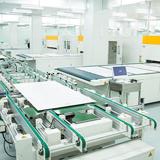

How to deal with the problems in the screen printing machine printing? You may not be familiar with the screen printing machine. The screen printing machine is a machine that prints text and images, and is a general term for machines or equipment used to produce printed products. The screen printing machine has evolved into a fully automatic step by step. Of course, some common problems will also be encountered during use. So how to deal with problems that occur during screen printing?
1. The printing pattern is not clear
Causes:
1. Improper ink selection or ink quality problems;
2. The ink dries too fast, making printed patterns or lines unclear, resulting in incomplete patterns or broken lines;
3. The viscosity of the ink is too high, resulting in incomplete patterns or broken lines during printing;
4. The phenomenon of plugging occurs in printing, which affects the normal over-inking of ink;
5. Insufficient or uneven scraper pressure during printing, resulting in uneven ink over;
6. The surface of the substrate is uneven.
Approach:
1. Replace the suitable ink;
2. Use a slower drying solvent to formulate the ink;
3. Dilute ink or add thixotropic agent to reduce viscosity;
4. Correctly select the slow-drying solvent to dilute the ink, and pay attention to the over-inking performance of the printing screen;
5. Increase the scraper strength during printing, and pay attention to the uniformity of the scraping force;
6. Treat the surface of the substrate (such as printing rough grain substrate can be printed with varnish or other materials before printing).
2. Ink is often blocked during printing, which affects normal use
Causes:
1. The ink itself dries too quickly or uses a quick-drying solvent to dilute the ink in a printing environment with a high temperature for commercial printing;
2. The viscosity of the ink is too high, causing plugging when printing small text or lines;
3. Inappropriate addition of solvent when adjusting the ink (such as adding a solvent that does not have enough solubility to cause the ink to return to thick, etc.);
4. The particles of the ink itself are too coarse, and the mesh of the printing plate is too high, and the ink cannot pass through the mesh normally.
Approach:
1. Replace the slow-drying ink or use a slower-drying solvent to mix the ink according to the printing environment;
2. Dilute the ink or add thixotropic agent to reduce the viscosity;
3. Use the specified solvent to dilute the ink so that the ink can be dissolved or dispersed normally;
4. Replace the finer ink.
3. The printed material has obvious netting
Causes:
1. The ink dries too quickly;
2. The viscosity of the ink is too high, the fluidity is not enough;
3. The mesh used is too coarse.
Approach:
1. Use a slower drying solvent to formulate the ink;
2. Dilute the ink or add thixotropic agent to reduce the viscosity and improve the flow performance of the ink;
3. Use mesh with higher mesh.
Fourth, the printed matter appears obvious water ripples
Causes:
The ink is too thin or the viscosity is too low, the screen pitch is too low when printing, and the ink is back sticking during printing;
elimination method:
Reduce the amount of solvent added to the ink, maintain the viscosity of the ink while appropriately adjusting the screen pitch, so that it can naturally rebound during printing.
5. Poor ink drying
Causes:
1. Improper selection of solvents can corrode the substrate (especially when printing soft PVC or film-coated nylon cloth);
2. The solvent dries too slowly or the drying time is insufficient.
Approach:
1. Choose a solvent that is compatible with the substrate;
2. Use a faster drying solvent or extend the drying time.
6. Poor ink adhesion
Causes:
1. The selected ink is not suitable for the substrate;
2. The surface of the substrate is not clean, there are oil stains or surface treatment agents (such as: preservatives \ release agent, etc.); In addition, some special materials, because the surface tension is too low will also affect the adhesion of the ink;
3. Insufficient drying time, the ink is not fully cured;
4. Excessive addition of additives or improper addition of additives;
5. Add too much additives or add improper ink.
Approach:
1. Correctly select the ink suitable for the substrate;
2. Handle the substrate surface or replace the substrate;
3. Extend the drying time so that the ink can be fully cured, especially for some inks with chronic cross-linking reaction (such as PET, PP, PE, etc.), it will take a long time to cure to have good adhesion;
4. Correctly add related additives;
5. Too much defoamer affects adhesion.
How to deal with the problems in the above screen printing machine is introduced here. In the screen printing, due to the choice of ink, the characteristics of the printing substrate, the uncertain printing environment factors, etc., it is easy to cause a variety of printing Failures affect the production cycle and product quality. Collect these processing methods to avoid these losses.
Cixi Network Co., Ltd. foil winding machine terminal machine, casing equipment
This article is transferred from: http://www.epole-print.com
Tel:15158365810
HTML:www.mysyqc.com
Add:No.185, bridge 3 road, xiaoqiaotou village, qiaotou town, cixi city